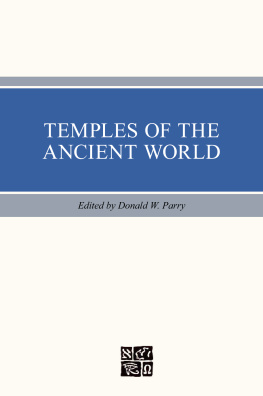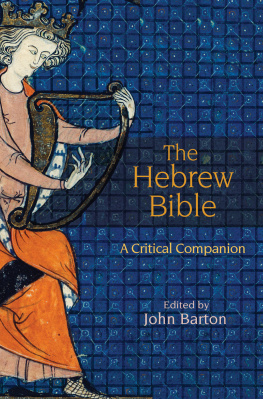Guide

Ritual Innovation in the Hebrew Bible and Early Judaism
Beihefte zur Zeitschrift fr die alttestamentliche Wissenschaft

Herausgegeben von
John Barton, Ronald Hendel, Reinhard G. Kratz, and Markus Witte
Band 468

ISBN 978-3-11-037273-1
e-ISBN (PDF) 978-3-11-036871-0
e-ISBN (EPUB) 978-3-11-039267-8
ISSN 0934-2575
Library of Congress Cataloging-in-Publication Data
A CIP catalog record for this book has been applied for at the Library of Congress.
Bibliographic information published by the Deutsche Nationalbibliothek
The Deutsche Nationalbibliothek lists this publication in the Deutsche Nationalbibliografie; detailed bibliographic data are available in the Internet at http://dnb.dnb.de.
2016 Walter de Gruyter GmbH, Berlin/Boston
www.degruyter.com
Preface
All but one of the essays in this volume originated as papers given for a special unit on Ritual Innovation in the Hebrew Bible and Early Judaism at the Society of Biblical Literature international meeting held in St Andrews in July 2013. I am grateful to my erstwhile colleague at St Andrews Kristin De Troyer who invited me to organize the special unit, and to all who participated in those sessions. The idea of examining ritual innovation had arisen in my own research on the Pentateuch a few years earlier and resulted in an essay entitled Ritual Innovation: The Feast of Weeks from the Covenant Code to the Temple Scroll, which was awarded the inaugural David Noel Freedman Award for Excellence and Creativity in Hebrew Bible Scholarship in 2011. A revised form of the essay is to be found in this volume and I am grateful to Bernard Levinson and Theodore Hiebert who responded to an oral version of the paper at the Society of Biblical Literatures annual meeting that year in San Francisco, as well as the awards committee. Finally I would like to thank the then editors of the Beihefte zur Zeitschrift fr die alttestamentliche Wissenschaft , Professors John Barton, Ron Hendel, Reinhard Kratz, and Markus Witte for accepting the volume into their fine series, and for their confidence then and since.
Nathan MacDonald
St Johns College, Cambridge
Nathan MacDonald
Strange Fire before the Lord: Thinking about Ritual Innovation in the Hebrew Bible and Early Judaism
At first blush ritual innovation would appear to be an oxymoron. What is ritual, if not a stereotyped behaviour that has to be practised consistently in order to be effective? This common-sense view of ritual is not without some justification, for rituals frequently appear to have a timeless quality. As Catherine Bell observes,
Rituals tend to present themselves as the unchanging, time-honored customs of an enduring community. Even when no such claims are explicitly made within or outside the rite, a variety of cultural dynamics tend to make us take it for granted that rituals are old in some way; any suggestion that they may be rather recently minted can give rise to consternation and confusion. Indeedpart of what makes behavior ritual-like is the way in which such practices imply the legitimacy of age and tradition.
Nevertheless, Bell (along with other ritual theorists) insists that rituals can and do change, and they can even be invented.
The possibility that rituals might be invented or that ritual innovation might occur has sometimes been treated by biblical scholars as counter-intuitive. Biblical legislation of ritual practice has often been assumed to be descriptive of actual practice. The Israelite cult was inherently conservative and when ritual change occurred it was a process so slow as to be entirely imperceptible to those participating in its rites. Such a perspective is found in Soggins reflections on the conservative function of the cult.
Given the traditional character of any form of public cult, we should not be surprised that its function is eminently conservative.. Jacob rightly pointed out that not only does the theological element of the great affirmations of the faith support the cult, but there are also the eminently conservative forces which the rite and the tradition preserve with particular tenacity, a long time after the thought which has inspired it has disappeared.
Such ideas are also evidenced in the occasional references to (linguistic) fossils or vestigial elements in scholarship on the priestly literature, our most important source of information on Israelite rituals.
As a result of these divergent perspectives on ritual innovation, there exist unresolved disagreements within Hebrew Bible scholarship about the nature and development of ancient Israelite religion, and fractures within American scholarship, and between Israeli and continental European scholarship. Focussed attention on the issue may, perhaps, help to remove some impasses, or at very least clarify the nature of the differences. It is in such a context and with such aims that the essays in this volume may be assesed.
Ritual Innovation in the Eyes of the Hebrew Bible s Composers
The instinct that the cult is conservative and that ritual innovation is rare or unusual is a perspective deeply ingrained in western culture and it has often been reflected in anthropological literature. significant texts, including the Bible. A surface reading of Israels historical narratives in Exodus2 Kings and 12 Chronicles suggests that the Israelite cult had its hoary origins in words from God at Mount Sinai mediated through Moses. A number of biblical narratives portray the negative consequences that result when the Pentateuchs prescriptions are set aside. Nadab and Abihus experiment in ritual innovation, or strange fire ( ) as the biblical text has it, is met with immediate and devastating punishment (Lev 10:12). Jeroboams thoroughgoing attempt to create a cult in the north with its own cult places, priesthood and festivals is emphasized through the repeated use of he made (). His novelties are unambiguously rejected by a deuteronomistic writer (1Kgs 12:25 33; 13:3334), and he becomes the archetypal ruler of the rebellious north, whose conduct ultimately leads to exile (2Kgs 17). Ahazs alterations to the architecture and furniture of the Jerusalem temple contribute to his portrayal as a king who did not follow in Davids footsteps (2Kgs 16), whilst Uzziah attempts to burn incense on the altar of incense result in him being struck down with leprosy (2Chron 26:16 21).
In his essay Saul Olyan examines a number of narratives that portray and condemn the usurpation of another partys ritual privileges, such as that of King Uzziah. Olyan reminds us of the importance of attending to the question of who gains through such acts of ritual innovation, and by the portrayal of them in this way. Such attempts at ritual innovation through usurpation are typically condemned by our texts, whose authors seek either to defend exclusive priestly claims against challenges posed by others, or cast priestly or other adversaries as corrupt and therefore, illegitimate, on account of their practices. Stories condemning ritual innovation guard existing structures of power, and point to the way that Pentateuchal rituals serve certain priestly hierarchies.
Olyan identifies a second form of ritual innovation that brings benefit to the manipulator of rituals. These involve the manipulation of mourning rites to shame and humiliate another party. Unlike the usurpation of priestly privileges, such ritual innovations are not inevitably rejected. When Shimi throws dirt on David, the humiliated king does not protest. Astonishingly he allows that Shimis actions may be due to divine impulse (2Sam 16:11). Nehemiahs act of pulling out the hair of those who were intermarried forces them into an act of mourning and humiliation. Nehemiah justifies his actions by appeal to the Pentateuchal law and stories from Israels ancient history. He is the hero of his own narrative and his actions are clearly regarded as justifiable and appropriate. Olyans examples demonstrate that some forms of ritual innovation were held to be acceptable by the Bibles narrators. Further examples would include the institution of Purim, whose historical origins in the Persian empire are clearly indicated in the story of Esther, the institution of fast days to memorialize the fall of Jerusalem (Zech 7:5 6), or the mourning of pilgrims after the destruction of the temple (Jer 41:45). Olyans identification of two forms of ritual innovation pose an important question for us: why were some rites viewed as improvisable, but others not?
















